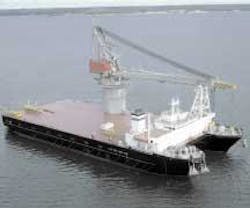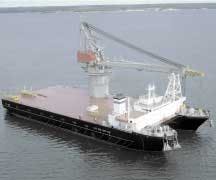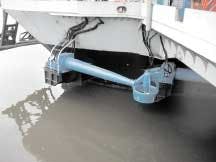Thrusters allow station-keeping ability in blackout
When Global Industries converted the Titan 2 heavy lift vessel for dynamic positioning (DP), the Louisiana-based company saw more benefits than expected. Although not one of the original goals, one result of the conversion was a vessel that can maintain station for at least 30 minutes during a complete electrical blackout.
In a typical blackout, most vessels would drift while backup power registered the extent of the drift. With the self-reliant thrusters used in this upgrade, said Keith Hebert, DP group operations supervisor, the Titan 2 will not drift during a 30-min blackout.
The Titan 2 was self propelled with four thrusters, two main zee drives of 2,200 hp each, and two tunnel thrusters at 200 hp each. The conversion added eight 1,000-hp hydraulic azimuthing thrusters to the heavy lift vessel. The conversion of the Titan 2 to a DNV class AUTR DP vessel began in mid 2001.
Minimal modifications to the hull and existing shipboard systems reduced time to the February 2002 delivery.
"We didn't have the added expense of dry docking and cutting into the hull to add the thrusters," Hebert said.
Since its delivery, the vessel has worked in the Bay of Campeche for Pemex. Its first job after the conversion was for the EPC 45 project. Global Industries is leasing the vessel.
null
Global Industries investigated alternatives to standard thruster installations, finally choosing products from Thrustmaster of Texas, which makes the 1,000-hp hydraulic azimuthing thrusters that mount to the outside of vessels.
The Bollinger Calcesieu Shipyard in Louisiana installed all of the DP equipment, Thrustmaster thrusters, and containers. The shipyard also performed the hull modifications to accept the thrusters, which were mounted with minor structural support modifications to the hull. Each thruster unit has a dedicated diesel engine powering hydraulic pumps for propulsion and azimuthing.
Bollinger installed each engine and pump set with one thruster per standard 20-ft ISO container. Global Industries said the thruster design was ideal because it required little hull work and no dry dock time. It also had minimal interface to the vessel's electric power plant, with the only requirement being a feed to the battery charger in each diesel/pump container unit. The other impact to the vessel's systems was a fuel line from the main diesel fuel tank to each pump container unit.
The company owns three DP vessels: Pioneer, Chickasaw, and Hercules.
null
DP systems automatically control and maintain a vessel's position and heading exclusively by means of active thrust. Modern DP systems use a variety of position sensors, such as DGPS, hydro-acoustics, laser rangers, and taut wires, for reference.
The DP computer blends data from each sensor to estimate the position. Although the DP system is normally thought of as just the computer, the entire vessel should be considered a system. Most DP systems rely on the vessel power plant for power to the thrusters, so anything connected to the power plant can affect the system. This is one of the critical differences between the Titan 2 installation and the majority of comparable DP installations.
The conversion
Global Industries installed eight Thrustmaster units – six at the bow and two at the stern. The existing vessel controls were modified so the new DP system could control the original thrusters without affecting the original controls. Although the existing tunnel thrusters interface to the DP system, the company anticipates using them only in extreme environmental or job conditions.
Bollinger installed the Kongsberg Simrad SDP21 and a Kongsberg Norcontrol Monitoring and Alarm System on the vessel. The new DP system provides inputs for two survey-supplied DGPS inputs and the existing ship's gyro. The system also includes two 3 KVA uninterruptible power supply (UPS) units, which provide up to 30 min of battery-supplied power to the DP hardware.
The shipyard installed the containers on the main deck near the associated thruster unit. Running the hydraulics from the containers to the thrusters by hose shortened the delivery time by several weeks. The choice also cost 80% less than the stainless pipe option.
Although not one of the major design goals, one of the biggest benefits of each thruster having its own self-contained power unit was the fact that the vessel could continue to maintain station after a total blackout of the ship's electrical plant. Except needing pressure to fill the fuel tanks occasionally, the new thrusters do not require the main power plant to operate.
Station-keeping during a blackout is limited to a half-hour because that is the capacity of the DP system UPS units with the current load. Additional power could be supplied to the UPS batteries to extend station-keeping capability indefinitely during a blackout. The Titan 2 does not require long-term blacked-out station-keeping capability, so there is no plan for extension beyond the existing 30-min rating, the company said. The thrusters have enough fuel in each container to run at full load for 12 hours, and longer during normal operations.
The thruster package design avoids the need for accurate rpm control or coordination between multiple engines. Individual diesels take care of individual thrusters. Controls are simplified compared to a bussed diesel-electrical power plant. A failure in a diesel engine or associated hydraulics cannot cause the loss of more than one thruster.
Along the critical path
For the DP system to control the ship's existing propulsion system, the controllers for both sets of original thrusters, built by Aquamaster and Kamewa, were modified. Rolls Royce has since acquired both of these companies directly or indirectly, so Rolls Royce was contracted to install the control upgrades for both systems.
One of the most difficult problems in the project was sorting out the new interface between the existing thruster controls and the new ones. The difficulty arose from the age and complexity of the original thruster controls, inadequate shipboard documentation, and the effects of multiple corporate relocations within Rolls Royce. The thruster problem very likely would not have been noticed on most DP conversions, but this conversion project went so smoothly that relatively minor interface problems quickly became critical path items, the company said.
Other major problems encountered were slipping feedback potentiometers on the Thrustmaster units, corroded wiring harnesses on the Cat engines, replacement of elderly shaft couplings on the main zee drive units, and reversed azimuth display meters. None of these would qualify as major problems on a normal DP conversion project.
An advantage of this design besides the station-keeping capability during blackout became increasingly apparent during the early stages of the failure modes effect analysis development. Because of the multiple redundancies in the system design, many power-related failure tests that are normally performed on DP vessels are immaterial on this vessel. The DNV environmental regularity number for this vessel was barely affected by most failure modes, Hebert said.


